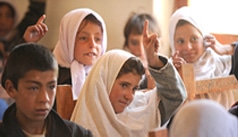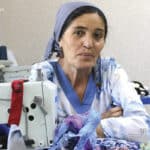Gender Equality in Afghan Education: Building a new start for a nation in turmoil
We want the education by which character is formed, the strength of mind is increased, the intellect is expanded, and by which one can stand on one’s own feet.
– Swami Vivekananda
At first glance, Afghanistan’s education system is struggling. The country has one of the lowest literacy rates in the world, with current estimates of less than one-third of adults able to read and write. For women, the numbers are even bleaker: an average of just 17% of women are literate, compared to 45% of men.
On paper, gender equality in Afghanistan is moot; legally, Afghan women have legal freedoms equal to men. But cultural expectations and conservative religious norms prevent many women from exercising those rights. Achieving gender equality in education, in particular, is hampered by the country’s security issues and lack of school infrastructure, funding, and resources. Today, only a third of Afghan girls attend school.
Seventeen years after the Taliban government was ousted from power, the country has not yet found its footing. The educational system, still reeling from a five-year period during which nearly all female education was prohibited – a true low for gender equality – has yet to reestablish large-scale education for the female half of its student population. The two largest roadblocks have been overcoming poverty in the war-torn region, and the task of helping girls and women who had been kept out of schools during Taliban rule catch up on years of missed studies.
But great progress has been made since the 2001 transition of power. At the time, fewer than 900,000 children attended school, most of them boys; today, that number has increased to nearly nine million children, with Afghan girls making up nearly half the total number.
Why girls and boys aren’t equally educated
The fact that gender inequality in Afghan schools still exists has a number of influences. Women are expected to marry early, have children, and stay at home. Security issues often create problems in traveling to and from school. In the capital city of Kabul, literacy rates are the highest in the nation for both genders; 68% for men, 34.7% for women. In more remote provinces, gender and geographical divides emerge; in Helmand province, the male literacy rate is 41% while the female rate drops as low as 1.6%.
Across the country, a lack of infrastructure is evident, as nearly half of all schools in Afghanistan do not have buildings. Classes are often held in temporary spaces, in tents, or outdoors. In a region subject to frequent violence, this is an unacceptably dangerous environment for young students. In addition to unsafe conditions, a lack of dedicated school buildings means students do not have access to bathroom facilities. For young girls, not being able to use the restroom and wash up in privacy is a source of cultural shame so strong that many girls end their schooling entirely upon reaching puberty.
Safe schools empower gender equality in education
When a safe, new school facility is built in an Afghan town, it truly changes the lives of those who live, work, and learn in the area. Providing access to private, sanitary restrooms, at schools within walking distance of their homes – an issue which seems so simple , yet holds the future hostage for so many – opens the door for thousands of girls to finally attend school. Young girls and women, empowered to start businesses, find jobs, and support themselves and their families financially for the first time, are bringing their voices to the decision-making table in powerful ways.
Central Asia Institute has helped build nearly 200 schools, each carrying with it a promise to help the community it serves. Each one of these schools has involved local support from the planning stage all the way to long-term sustainability, and from each school emerges young women who will grow up to pursue their dreams. Your support for CAI has a great impact on gender equality in the remote villages of Afghanistan, and the country’s future.












One response to “Gender Equality in Afghan Education: Building a new start for a nation in turmoil”
[…] with only around 17% of them being literate, compared to 45% of men. When it comes to fighting for gender equality, it is not always that simple, especially when certain countries have been used to this way of life […]